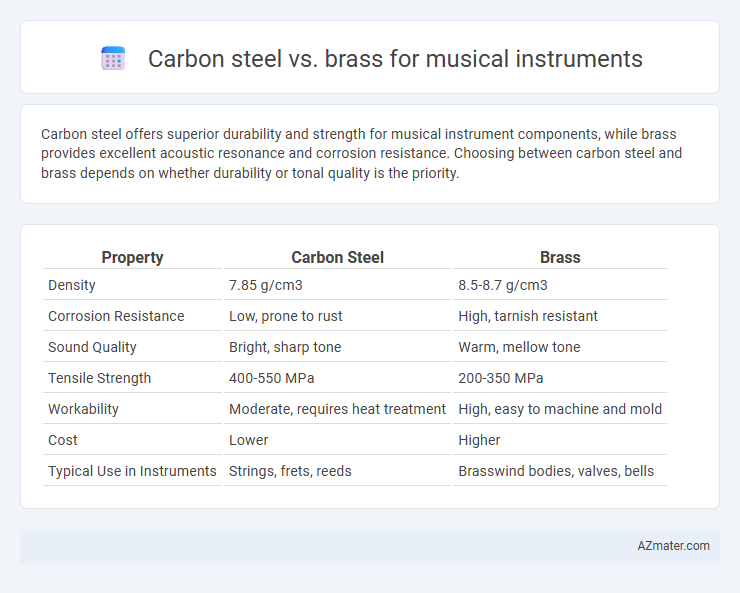Carbon steel offers superior durability and strength for musical instrument components, while brass provides excellent acoustic resonance and corrosion resistance. Choosing between carbon steel and brass depends on whether durability or tonal quality is the priority.
Table of Comparison
| Property | Carbon Steel | Brass |
|---|---|---|
| Density | 7.85 g/cm3 | 8.5-8.7 g/cm3 |
| Corrosion Resistance | Low, prone to rust | High, tarnish resistant |
| Sound Quality | Bright, sharp tone | Warm, mellow tone |
| Tensile Strength | 400-550 MPa | 200-350 MPa |
| Workability | Moderate, requires heat treatment | High, easy to machine and mold |
| Cost | Lower | Higher |
| Typical Use in Instruments | Strings, frets, reeds | Brasswind bodies, valves, bells |
Introduction: Comparing Carbon Steel and Brass in Musical Instruments
Carbon steel and brass are widely used materials in the construction of musical instruments, each offering distinct acoustic properties and durability. Carbon steel provides enhanced strength and resistance to deformation, making it ideal for components like guitar strings and certain percussion parts. Brass, known for its excellent tonal warmth and corrosion resistance, is commonly employed in wind instruments such as trumpets and saxophones, where it contributes to rich sound quality and longevity.
Material Properties: Carbon Steel vs Brass
Carbon steel offers high strength and durability, making it suitable for musical instruments requiring wear resistance and structural integrity, such as guitar strings and keys. Brass provides superior corrosion resistance, excellent machinability, and a warm, bright tonal quality, commonly used in trumpets, saxophones, and brass valves. The choice between carbon steel and brass depends on the desired balance of rigidity, tonal warmth, and resistance to environmental factors.
Sound Quality and Tonal Differences
Carbon steel produces a brighter, more focused sound with increased projection and clarity, making it ideal for instruments requiring sharp articulation and sustain. Brass offers a warmer, richer tone with complex overtones, contributing to a fuller, more resonant sound favored in brasswind instruments. The choice between carbon steel and brass significantly impacts the instrument's timbre, dynamic range, and overall tonal character.
Durability and Maintenance Concerns
Carbon steel offers superior durability compared to brass, resisting deformation and impact better, making it ideal for instruments exposed to rough handling. Brass, while softer and more prone to dents, requires frequent polishing to prevent tarnish and corrosion, demanding higher maintenance. Both metals respond differently to environmental factors: carbon steel is more resistant to moisture-related corrosion when properly coated, whereas brass naturally forms a protective patina but can corrode under acidic conditions.
Weight and Playing Comfort
Carbon steel offers a heavier weight that provides stability but may cause fatigue during extended playing sessions, while brass is lighter, enhancing ease of handling and reducing player strain. Brass's lower density contributes to a more comfortable grip and better control, especially beneficial for wind instruments and percussion. Weight differences between carbon steel and brass significantly impact playing comfort, influencing instrument choice based on the musician's endurance and performance style.
Manufacturing Versatility and Customization
Carbon steel offers superior manufacturing versatility for musical instruments due to its high strength and ease of machining, allowing precise customization of shapes and components. Brass, favored for its excellent corrosion resistance and acoustic properties, enables detailed craftsmanship and surface finishing that enhances instrument aesthetics and sound quality. The choice between carbon steel and brass hinges on balancing mechanical adaptability with tonal characteristics, making each suitable for different customization requirements in instrument production.
Corrosion Resistance and Lifespan
Carbon steel offers superior strength but is highly susceptible to corrosion, requiring regular maintenance to prevent rust and extend lifespan in musical instruments. Brass exhibits excellent corrosion resistance due to its copper content, resulting in a longer lifespan and lower maintenance for instruments exposed to moisture and frequent handling. The enhanced durability and natural tarnish resistance of brass make it the preferred choice for wind instruments, while carbon steel is often reserved for components needing higher tensile strength but protected from harsh environments.
Cost and Market Availability
Carbon steel offers a cost-effective option for musical instruments, benefiting from widespread market availability due to its extensive use in industrial applications. Brass, generally more expensive, is preferred for its superior acoustic properties and aesthetic appeal, but can be less accessible depending on regional metal supply chains. The choice between carbon steel and brass hinges on balancing budget constraints with desired sound quality and availability in local markets.
Popular Instrument Types for Each Material
Carbon steel is primarily used in musical instrument components like piano strings and guitar frets due to its high tensile strength and durability, making it ideal for instruments requiring precise tension and long-lasting performance. Brass is extensively popular for wind instruments such as trumpets, trombones, and saxophones, valued for its excellent acoustic properties and corrosion resistance that produce bright, rich tones. Both materials serve distinct roles based on their mechanical and acoustic characteristics, with carbon steel favored for stringed instrument hardware and brass dominating in the construction of brasswinds.
Choosing the Right Material for Your Musical Needs
Carbon steel offers durability and a bright, focused tone ideal for wind instruments like flutes and saxophones, providing resistance to wear and easy maintenance. Brass, composed primarily of copper and zinc, produces a warm, rich sound with excellent resonance, commonly preferred for trumpets, trombones, and tubas due to its superior acoustic properties. Selecting between carbon steel and brass depends on the desired tonal quality, instrument type, and performance requirements, with brass favored for warmth and resonance, while carbon steel is chosen for robustness and brightness.

Infographic: Carbon steel vs Brass for Musical instrument
 azmater.com
azmater.com